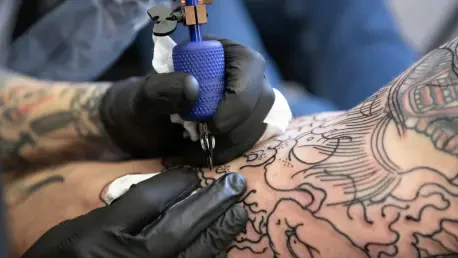In recent years, the growing popularity of tattoos has prompted researchers and the public to scrutinize their potential health implications, particularly concerning cancer and infections. With the rising prevalence of tattoos, it’s essential to examine the potential health risks these artistic expressions could silently harbor. Recent studies have emerged, shedding light on a possible link between tattoos and an increased risk of both blood and skin cancer. These investigations have sparked an intriguing and necessary discourse, signaling the need for greater understanding and awareness regarding the safety of tattoo inks and procedures.
The Connection Between Tattoos and Cancer Risks
Blood Cancer: Investigating Lymphoma Risks
One of the most concerning findings in current scientific literature relates to the potential increased risk of blood cancer, specifically lymphoma. A significant study from Lund University unearthed crucial insights, showing that individuals with tattoos face a 21% heightened risk of developing lymphoma. The data sourced spans an extensive timeline, focusing on developments within the Swedish National Cancer Register up to 2025. This alarming statistic suggests a need for individuals considering tattoos to weigh such risks carefully. The suspected mechanism involves certain compounds in tattoo inks that might contribute to carcinogenic activities in the body, potentially triggering the onset of blood cancer. Therefore, the emphasis is not just on the artistry of tattoos but also on the choice of inks, their composition, and the long-term implications of these choices.
Additionally, there is a growing focus on understanding the specifics of how different ink components might interact with human biology to raise cancer risks. Researchers are delving into these potential biological mechanisms, striving to delineate the pathways these compounds may use to disrupt cellular processes, contributing to cancer development. However, it’s crucial to realize that the relationship between tattoos and cancer isn’t entirely conclusive at this point, with ongoing research needed to ascertain the direct connections and underlying causations involved. Despite this, current findings urge caution and further investigations to unravel the truth fully.
Skin Cancer Concerns: Ink Components and Risks
Parallel to concerns about blood cancer, questions also arise about tattoos’ correlation with skin cancer, a subject attracting considerable attention from dermatological researchers. The skin, being the canvas for tattoos, may interact with hazardous substances found in some tattoo inks. Some ingredients identified in various ink compositions are considered potential carcinogens, stirring up valid concerns regarding their direct impact on skin cancer risks. Considering the skin’s vital role as a barrier, understanding how tattoo components can alter this dynamic is of utmost importance.
Moreover, some inks contain compounds known to degrade over time, potentially releasing harmful substances directly onto the skin or into the circulatory system. This slow degradation process magnifies concerns surrounding long-term exposure and its cumulative effects, necessitating thorough exploration. Despite the potential, the direct link between tattoos and skin cancer remains an area intensely researched but not yet decisively concluded. With continuous advancements in understanding these risks, individuals are encouraged to remain informed and consider the implications of their tattoo choices more critically.
Tattoos and Infections: Unveiling Contamination Risks
The Role of Bacterial Contaminants
Infections represent another significant health consideration associated with tattoos, stemming primarily from bacteria present in tattoo inks. A pertinent study featured in Applied and Environmental Microbiology detected bacterial contamination in a notable portion of tested tattoo inks. Specifically, out of 75 inks scrutinized, 26 harbored bacteria, indicating an alarming trend and emphasizing the importance of ink sterilization. Among the detected bacteria were Staphylococcus epidermidis, known for causing infections, and Cutibacterium acnes, linked to acne formation. Such findings underline the necessity of maintaining stringent hygiene standards in tattoo parlors to mitigate infection risks.
The presence of bacteria in inks raises questions about manufacturing practices, storage conditions, and handling procedures. These aspects significantly influence the sterility of inks, with potential contamination leading to infections post-tattooing. Ensuring comprehensive regulations and adherence to quality standards remain key strategies in reducing such risks, while public education plays an essential role. Additionally, practitioners are encouraged to uphold elevated hygiene practices, ensuring both equipment and inks remain uncontaminated, offering clients a safer tattooing experience.
Preventative Measures and Industry Responsibility
The tattoo industry’s responsibility in maintaining health standards and mitigating infection risks cannot be overstated. Emphasizing proper sterilization techniques during the tattooing process and ensuring the use of high-quality, safe inks is paramount. Educating practitioners and clients about infection prevention, bacterial contamination, and aftercare practices remains crucial in safeguarding health. It’s equally important for potential clients to research thoroughly, selecting reputable tattoo artists committed to maintaining rigorous health standards.
Looking forward, industry stakeholders, researchers, and regulators must collaborate to establish more robust guidelines for ink production and application standards, ensuring safer tattoos. Awareness initiatives targeting both practitioners and consumers can foster a culture of informed decision-making and prioritize health considerations. While expressive and meaningful, tattoos must be pursued with due diligence and awareness, embracing a holistic approach to personal safety and artistic creativity alike.
Future Considerations and Moving Forward
In recent years, tattoos have gained tremendous popularity, encouraging both researchers and the general public to examine their possible health repercussions, particularly those associated with cancer and infections. As tattoo prevalence continues to rise, it’s vital to delve into the prospective health hazards that these artistic inkings might covertly entail. Recent research has suggested a possible connection between tattoos and a heightened risk of blood and skin cancers. These studies have incited meaningful discussions around the safety of tattoo inks and practices. It underscores the necessity for greater consciousness and comprehension regarding the materials used in tattoo ink and the methods employed during tattooing procedures. Given the profound implications for public health, these findings necessitate increased vigilance and potentially revised health guidelines to better protect individuals opting for tattoos. Understanding these risks could lead to safer practices and informed choices for those considering body art.









